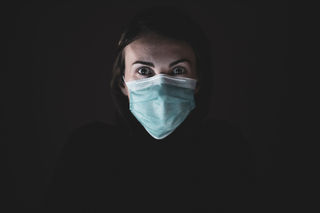Anxiety
We Are Wired to Feel Anxious During a Pandemic
That doesn't mean our anxiety has to consume us.
Posted April 13, 2020

A few weeks ago, my husband told me that he might quarantine himself in the hospital where he works as a physician if exposed to the novel coronavirus in order to avoid contaminating the rest of our family. At the time, I felt anxious about the prospect of becoming a de facto single parent while he fought on the front lines in the battle against COVID-19. Being alone with two young kids for long stretches of time is not easy and the thought of being stuck in the house with them for weeks on end by myself was difficult to swallow.
Though I also worried about the possibility of my husband getting infected, this did not scare me too much at the time. In fact, it seemed almost inevitable that he would get sick with COVID-19, perhaps even severely, given his occupation. Luckily, however, as an expert in treating anxiety, I am quite skilled when it comes to managing thoughts about uncontrollable, worst-case-scenarios and knew that trying to avoid these thoughts or reassure myself would only intensify my frightening what-ifs.
And so, standing next to my partner that night, it was relatively easy to say to myself that he could become severely ill—or even die—from COVID-19, leaving me and the kids alone forevermore. Sure, I felt some anxiety while leaning into this possibility, but it quickly dissipated, allowing me to move on with my evening.
An Evidence-Based Approach to Managing Anxiety
For those familiar with a form of cognitive-behavioral therapy called exposure therapy, this approach will likely sound familiar. Exposure therapy is a highly effective, evidence-based treatment for anxiety and related disorders that aims to block the avoidance behaviors that tend to maintain and exacerbate anxiety over time. Treatment is focused on helping individuals approach objectively safe but anxiety-provoking thoughts and situations in the absence of any avoidance behaviors, including mental rituals, in order to help them learn that they can tolerate distress and the uncertainty that often fuels it.
Of note, although exposures tend to increase anxiety at first, prolonged and repeated exposure practice typically results in large reductions in anxiety. Yet, perhaps even more important, exposure therapy teaches individuals how to become more comfortable being uncomfortable. As strange as this might sound, this is an incredibly useful skill to have—especially while living in the midst of a deadly pandemic. The key, however, is in remembering to use it.
Using Exposure to Target COVID Anxiety
A few days after my husband brought up the possibility of quarantining himself in the hospital, I became sick with a low-grade fever, a persistent cough, shortness of breath, nausea, and body aches, and I discovered that anxiety is a very different beast when a pernicious pathogen appears to be residing within you. Although I believed that I would likely be fine even if I did have COVID-19, the intense discomfort that I felt while sick left me terrified for others; especially my family, who, for varying reasons, I worried might not fare as well as me if they contracted the virus. Within no time, I, the anxiety specialist, had begun to travel down my own bottomless rabbit hole of worries.
Thankfully, after a few hours of worrying and researching, the rational side of my brain kicked in and I realized that my worries and unproductive Google searches weren’t doing anyone any good. Indeed, aside from following CDC guidelines, there wasn’t much that I could do while sick other than hope for the best while accepting that my scariest nightmares could one day become reality.
The good news is that my symptoms remained mild and my test for the virus came back negative. The bad news is that there is still a good chance that my husband will contract the virus while caring for patients and that all of my worries could then come true. However, rather than stew on my worries, I am saving my energy for the things that I can control and most value, and am making the conscious choice to live in the present; especially when with family.
Mindfulness Can Help, Too
Though uncertainty abounds even when we are not in a pandemic, one thing that is certain is that our worries will grow the more we feed them. Thus, if we let ourselves worry and watch COVID-related news all day, our anxiety will almost invariably continue to mount. That said, as noted above, a large body of evidence suggests that trying to avoid anxiety-provoking thoughts actually makes these thoughts pop up with greater frequency and intensity. Yet, although acknowledging the possibility of our feared outcomes can be immensely helpful in quieting intrusive thoughts, we can't spend every waking moment repeating these exposure statements; nor would we want to. And this is where mindfulness comes into play.
Mindfulness, which involves focusing our entire attention on the present moment without judgment, is something that we can use anytime, anywhere. For instance, we can practice mindfulness when laying in bed, breathing, walking outside, washing the dishes, sitting in a meeting, or caring for our children. We simply need to choose to pay attention to our chosen activity and be willing to shift our attention back onto that activity when our mind wanders. Thus, when worries arise, we can acknowledge that our feared outcomes could (note, not necessarily will) happen and then gently redirect our attention back onto whatever we were mindfully attending to, even if our worries continue to buzz around in the background.
Notably, regular mindfulness practice has been found to result in decreased depression and anxiety, increased well-being, improved emotion regulation, and many other beneficial psychological and physical outcomes.1 Accordingly, whether you are spending your time during this pandemic caring for patients hospitalized with COVID-19, working from home, taking care of your kids, bingeing on Netflix, or all of the above, it's worth giving mindfulness a shot. And what's so great about mindfulness is that it doesn't require carving out any additional time to practice it. Instead, we can practice mindfulness while doing whatever it is that we are already doing.
Pairing Mindfulness with Exposure
It has now been a month since my kids' schools closed and I have actually been enjoying this time at home with them much more than I thought I would. As a therapist in private practice, I have the luxury of setting my own work schedule and have temporarily shifted to seeing patients via telepsychology at night only, thus enabling me to be more attentive when with my kids. Although I am tired and have little downtime to myself these days, giving up activities that don't do much to fill my cup (e.g., using social media) has freed up minutes that I never knew I had.
Mostly though, my time is spent with my kids. Sometimes we dance, sing, and laugh. Other times, we just barely manage to make it through the day without one kid killing the other. Yet, no matter what these days at home bring, navigating them is easiest (and most enjoyable) when I am able to mindfully observe and accept each moment as it unfolds, rather than dwell on how I wish things would be or on how I fear they might be. Although worries and judgments sometimes creep in, replacing these with acceptance and curiosity helps me respond calmly to whatever my kids throw my way. This, in turn, enables me to be the compassionate, loving mom that I know my kids need right now given the unusual stress that we are all facing. In fact, remaining calm and connected is just as much for me as it is for them.
Over the years, I've come to realize that the chaos that my kids sometimes create is much like the anxiety that I help my patients overcome. Although I certainly have urges to yell or shame my kids at times, these strategies usually only work in the short run (if at all) and tend to amplify and prolong both my distress and theirs in the long run. In other words, like anxiety, the more I try to fight the chaos or command it to stop, the more intense it gets. By contrast, as is the case with anxiety, blocking my children's harmful or destructive behaviors while welcoming and acknowledging the feelings driving these behaviors works much, much better.
Navigating Uncertain, Challenging Times with Presence
It is for this reason that I have come to think of parenting in the midst of a pandemic as one giant exposure. Not only do we have to sit with the anxiety that comes with not knowing how all of this will play out, but we also have to sit with the discomfort that all parents of young children are bound to face here and there, especially while following stay-at-home orders. Yet, as hard as all of this might feel, the more that we can resist our urges to engage in unhelpful, emotionally-driven behaviors, the more we will all be able to grow and even thrive. We just need to be willing to let go of striving to control the uncontrollable. After all, as unfortunate and tragic as the current circumstances are, I can't imagine a more ripe opportunity to practice exercising our muscles for tolerating uncertainty and distress.
Do I still feel anxious? You bet! We are wired to feel anxious about potential threats and it would be risky to not feel anxiety in the midst of a deadly pandemic. Indeed, it is anxiety that drives us to take the precautions that we need to be taking right now, like staying at home. Yet, my own personal fight with what at first appeared to be COVID-19 has shifted the lens through which I approach the uncharted waters that lie ahead of us. Instead of spending my time worrying and looking for land that is clearly out of sight, I am determined to live however many more days we spend on this rocky sea with presence, riding each wave that comes as skillfully as possible.
References
1. Khoury, B., Lecomte, T., Fortin, G., Masse, M., Therien, P., Bouchard, V., … & Hofmann, S.G. (2013). Mindfulness‐based therapy: A comprehensive meta‐analysis. Clinical Psychology Review, 33, 763–771. doi: 10.1016/j.cpr.2013.05.005




